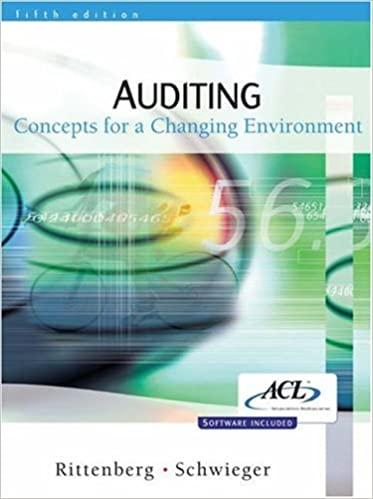Question
Directions: Read the following case information and answer the question(s). P repare your answer for this discussion topic which will be due for class on
Directions: Read the following case information and answer the question(s). Prepare your answer for this discussion topic which will be due for class on Monday, May 1, 2017. Your answer should be at least 1/2 page double-spaced and in your own words. Be prepared to discuss the topic with your classmates also. No one student will be expected to carry the discussion. All students will be expected to participate in order to receive full credit.
On the same day, May 6, 2002, that jury selection began in the criminal case against Arthur Andersen in Houston concerning Enron, Arthur Andersen agreed to pay $217 million to defrauded investors in the Baptist Foundation of Arizona. The foundation's bankruptcy was the largest financial failure of a religious non-profit in history. The Andersen settlement was the second-largest ever paid by a Big Five accounting firm at that time and was more than twice the largest settlement Andersen had paid before. Andersen admitted to no wrongdoing in the case.
The board of trustees found out about problems through a state investigation a year before the foundation went bankrupt in November 1999. The Arizona Corporation Commission ordered the Baptist Foundation of Arizona (BFA) and affiliated companies Arizona Southern Baptist New Church Ventures and Christian Financial Partners Inc. to cease "offering and selling securities in violation of the Securities Act of Arizona." The section of the law cited by the commission is titled "Fraudulent Practices. It's a complex Ponzi scheme, that's my statement," said Corporation Commissioner Bill Mundell during a commission hearing. Commission attorney Leroy Johnson said BFA and the affiliated companies had sold in excess of $500 million worth of securities to more than 13,000 investors.
The bankruptcy imperiled more than $500 million lent to BFA by Christian investors, churches, IRA accounts and trust funds managed by BFA. In solicitations at Baptist nursing homes and in churches, BFA representatives had persuaded many elderly parishioners to "invest" their life savings with BFA by insisting that BFA's profits benefited Christian causes. But by 1998, the last year for which figures are available, BFA had in 50 years returned only a total of $1.3 million of its own money to Christian causes.
"Somebody on that board should have taken five minutes to look at the audited financial statement . . . there were red flags flying all over the place," said Dee Griebel, an investment adviser who counseled clients not to invest with BFA. She said she alerted BFA to its severe financial problems a year ago, but that BFA failed to take care of the problem and instead reaped another $50 million from unsuspecting investors.
Dan Guy, a director of the American Society of Certified Public Accountants, accused Andersen of an "unpardonable" breach of accounting standards. A 1997 audit report of foundation accounts "falls below the minimum accounting standards" and "should never have been released," he testified. Guy, who studied Andersen case files in the audit, said an auditing team failed to investigate charges of financial misconduct, issuing a clean bill of health. At the least, he said, auditors should have tested the foundation's ability to operate as a going concern, which likely would have disclosed its shaky finances. He said Andersen missed red flags, including warnings by one of its own accountants, an anonymous call to its Chicago office and a series of investigative newspaper articles quoting former foundation employees.
Read over the information regarding the auditors responsibility concerning the going-concern status of a company on pages 677-678. What as a minimum should Arthur Andersen have done if there were indications that the Baptist Foundation could not continue to operate as a going concern? Do you think the failure of The Baptist Foundation audit at the same time as Enron indicates there was a wide-spread problem at Andersen?
Sources Terry Green Sterling, Fraudulent Practices, Phoenix New Times, Thursday, August 12, 1999. Bob Allen, Arthur Andersen Settles Yet Again, with Arizona Foundation Investors, Associated Baptist Press, May 13, 2002.
Step by Step Solution
There are 3 Steps involved in it
Step: 1

Get Instant Access to Expert-Tailored Solutions
See step-by-step solutions with expert insights and AI powered tools for academic success
Step: 2

Step: 3

Ace Your Homework with AI
Get the answers you need in no time with our AI-driven, step-by-step assistance
Get Started


